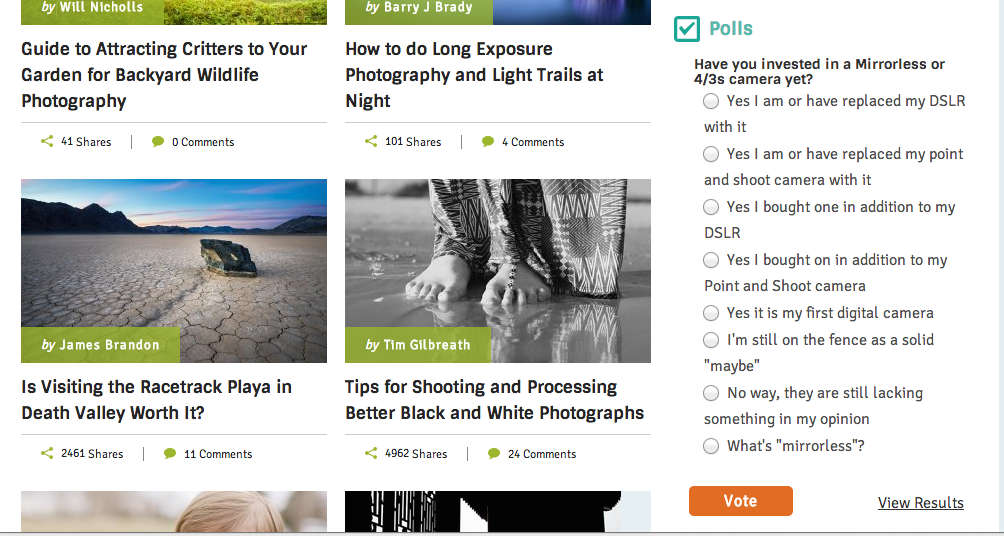

Theme Week: You’ve Got Readers To Your Blog – This is How You Keep Them There
There’s no denying that driving traffic to your posts is usually at the top of every blogger’s list once they hit “publish”. And while we’ve chatted this week about sharing your posts on social media for the best effect, and how to repurpose your content so even more eyes see it – it’s time now to talk about keeping those visitors on your blog once they get there, interacting with your content, and engaging with you.
Reader comments
Reward your readers
Replying to the comments you do get is one of the best things you can do – not only to encourage that person to be a repeat reader, but also to show other readers that you’re interested in the stories they might like to share. When you put the effort in to have conversations with the people who make an effort to speak to you, it fosters more of a community environment.
Email your thanks
Darren talks about taking the time to email your readers to either thank them for their comment, or to follow up on something they’ve talked about. It is taking the extra step that will make them feel appreciated and more inclined to spend their time on your blog, where they know they will be heard, appreciated, and made to feel welcome.
Ask a question in your reply
If your reader tells you a story or shares an anecdote with you, ask them further questions about it in your reply. It’s likely they’ll come back again and answer you, and you’ve created the beginning of a conversation, not just been hit by a “drop and run” commenter.
Invite future comments
If a reader tells you they’re going to put your advice into action, or make your recipe, or in some other way take your blog into their real life, ask them to let you know how that turns out for them. When they do come back, you can then ask them even more questions: What was easy? What did they find difficult or confusing? Did they enjoy the end result?
Foster conversations between readers
When replying to people who have commented on your blog, you can tag other people in your comments, or highlight where someone’s said something similar, or answered the question they’re asking. You can put the call out for other readers to share their experience, or answer the commenter’s question in your reply to them. By making the environment on the blog conducive to conversation and then letting your readers exchange with each other, you’re only going to see a rise in engagement. This is one of Mrs Woog’s secrets to a highly-engaged community of readers.
“It is the facilitation of these conversations that will give you a really great insight into who your readers actually are. It is this information that will help you to work out what sort of content to deliver to them. What will work, and what will sink.”
Give considered responses
In today’s fast-paced, bite-sized world, a comment is an absolute gift. That someone took the time to read your post, form an opinion, sign in, and leave a comment? and/or perhaps even share your post? that deserves more than a “thanks” or some other brief nod of the head, when you can spare it. Sure, if you don’t have time to reply to every single comment you ever get, then this is better than nothing. But if you can give a chatty reply back, then you are more likely to entice others that it’s worth their time and effort to get involved.
Provide further information
Be useful to your readers not only in the body of your posts, but in your replies to them too. If there’s more information you can point them to, then do so. If there’s someone else’s blog post you can highlight – even better. They might even come back and thank you.
Link your content
If you’re talking about things you’ve covered in posts elsewhere, then highlight that in your text. If the reader doesn’t find anything in this post to respond to, they might be interested enough in something you’ve linked to and feel encouraged to leave a comment there.
Ask questions in your posts
A useful strategy to encourage readers to comment is to not only ask them a question at the end of your post, but also to weave in open-ended questions throughout your text. Create many jumping-off points to start conversations, and let people choose which ones they want. By asking for advice or reader experiences, you’re providing a forum for people to share.
Start a debate
Everybody knows that controversy is one way of getting eyeballs and engagement. It’s not for the faint-hearted, but even smaller-scale contentious points can entice people to comment on which side of the debate they are on. It could be as innocuous as asking readers whether they prefer peanut butter or honey on their morning toast, but it still inspires a desire to answer.
Use a poll
Further to the debate idea, asking readers to answer a question about where they stand on a subject can be a quick and easy way for people to engage. You can create a post around it, or even have them permanently in the sidebar like the ones on Digital Photography School.
Reader projects
If you and your readers are participating in a blogging challenge, or another type of community project, it can foster a great environment for people to come together to chat about it. It might be something as big as 31 Days to Build a Better Blog, or it could be a fun creative exercise, like blogging every day for a month. When everyone’s in it together, there’s more of a chance they’ll stick around for the conversation.
Hold back a bit
If you say everything that’s needed to be said in a post, then there’s not much for the reader to contribute. While expert, informative posts are incredibly useful, it’s also a much better outcome if the readers are participating in a conversation around it, rather than just writing “great post!”. Leave them something to add.
Be a mini-expert in something specific
There’s lots of posts on the internet solving common problems. Where you might have more luck with engagement is solving a rare problem that isn’t often covered. I have a post about recovering documents that are saved to Office 2011 Autorecovery. I pieced it together after a very stressful lost-file incident, from advice spread throughout many pages and forums. It is so specific I wasn’t sure if it would be useful to many people, but it consistently gets not only regular views, but regular comments from truly relieved and grateful readers who found it at their wit’s end. Even if you think only a handful of interested people will read the post, you might be the only person writing that particular solution to that particular problem.
Site setup
User-friendliness
If your site is clear, easy-to-read, and gives the viewer a pleasing visual experience (like Dustin talked about here in our last theme week on creating community), it’s more likely they will stay. The longer they stay, the more likely they are to want to engage with you. Dustin says:
“When someone lands on your webpage you have five seconds or less to prove that your site and its content is worth their precious time. So if your web design is cluttered, hard-to-read and visually unattractive, you’re content may not have the chance it deserves.”
Make it easy
There’s nothing more off-putting than a hidden comment section, a cluttered comment section, a hard-to-sign-into comment section, or a comment section that requires you to fill in the captcha code. I’ve heard readers say time and time again that they just give up when they can’t get the captcha right. Others go so far as to not even bother trying.
Point people to newsletters
You’re full of useful information, so ensure you’re letting readers know that you’ve got even more of it that isn’t always on the blog. Keep eyeballs on your site by making it easy for them to click over. If they’ve signed up to receive your newsletter, it might be the incentive they need to visit your blog when it arrives in their inbox. Make your newsletter visible and easy to sign up for. Also include it at the end of your popular posts, or in the body of your posts (when logical to do so, of course).
Call to action
It’s obvious, but still not everyone does it – asking outright for comments. Maybe you feel weird about asking readers directly to comment or share (I know I do!), but it appears to be very effective. Whether it’s a casual “I’d love to hear your thoughts” or even a “please comment”, it might be just the push the reader needs to reply.
Think about the kind of reader you are
What entices you to spend time on someone else’s blog and join in their conversation? Think about the kinds of things you like to see and enjoy elsewhere and see if you can’t replicate similar things on your site. There’s a good chance that if you like it on other blogs, your readers will like it on yours.
Make sure they’re notified when you reply
The best way of keeping engagements high is ensuring your commenters know when you’ve continued the conversation. Not everyone checks back to see if they’ve been replied to, but if they have an email notification (such as a Disqus reply) or similar, then it’s more likely they will come back to chat.
Off your blog
Keep an eye on your pingbacks/trackbacks
When you see that someone has mentioned you on their site, it takes two seconds to pop over and thank them for it. By showing you’re grateful and interested in what they have to say means it’s more likely that reader will keep being engaged in your blog and your work.
Return the favour
Being an active participant in the blog community does wonders for the kinds of engagement you can create in your own space. Reciprocity is a perpetuating cycle that’s beneficial for all involved. Comment often. Comment freely. Comment without expectation, but just enjoying the process. Comments beget comments, and while not everyone will return the favour to you, many will. Be one of the people who do.
Reply on social media
While ultimately it is beneficial to have people solely comment on your blog, it is good practice (and a lot of fun!) to reply to their comments on Facebook or Twitter about your post. Some people prefer to have conversations there, and some people are new to you. They might be more incentivised to click over and read if you’re taking the time to care about what they say on their social media of choice.
What about you? What have you found to be a useful way of keeping people engaged on your blog posts, and not just skipping off to the next distraction?
Stacey Roberts is the Managing Editor of ProBlogger.net, and the blogger behind Veggie Mama. A writer, blogger, and full-time word nerd, she can be found making play-dough, reading The Cat in the Hat for the eleventh time, and avoiding the laundry. See evidence on Instagram here, on Facebook here, and twitter @veggie_mama.
Originally at: Blog Tips at ProBlogger
Theme Week: You’ve Got Readers To Your Blog – This is How You Keep Them There
Facebook comments:
No Comments »
No comments yet.
RSS feed for comments on this post. TrackBack URL
Leave a comment


















